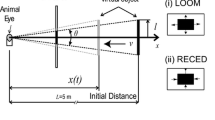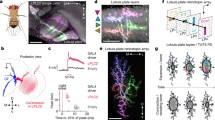Abstract
The processing of visual information for collision avoidance has been investigated at the biophysical level in several model systems. In grasshoppers, the (so-called) \(\eta \) model captures reasonably well the visual processing performed by an identified neuron called the lobular giant movement detector as it tracks approaching objects. Similar phenomenological models have been used to describe either the firing rate or the membrane potential of neurons responsible for visually guided collision avoidance in other animals. Specifically, in goldfish, the \(\kappa \) model has been proposed to describe the Mauthner cell, an identified neuron involved in startle escape responses. In the vinegar fly, a third model was developed for the giant fiber neuron, which triggers last resort escapes immediately before an impending collision. One key property of these models is their prediction that peak neuronal responses occur at a fixed delay after the simulated approaching object reaches a threshold angular size on the retina. This prediction is valid for simulated objects approaching at a constant speed. We tested whether it remains valid when approaching objects accelerate. After characterizing and comparing the models’ responses to accelerating and constant speed stimuli, we find that the prediction holds true for the \(\kappa \) and the giant fiber model, but not for the \(\eta \) model. These results suggest that acceleration in the approach trajectory of an object may help distinguish and further constrain the neuronal computations required for collision avoidance in grasshoppers, fish and vinegar flies.






Similar content being viewed by others
Data availability
The MATLAB code required to reproduce all the figures and the statistical analysis of surrogate data for nonzero acceleration stimuli presented in Sec. 5 is available online at Mendeley Data (repository DOI: https://doi.org/10.17632/rvrz2tmf7j.1)).
References
Ache JM, Polsky J, Alghailani S et al (2019) Neural basis for looming size and velocity encoding in the Drosophila giant fiber escape pathway. Curr Biol 29:1073–1081. https://doi.org/10.1016/j.cub.2019.01.079
Bennett C, Gale SD, Garrett ME et al (2019) Higher-order thalamic circuits channel parallel streams of visual information in mice. Neuron 102(2):477-492.e5. https://doi.org/10.1016/j.neuron.2019.02.010
Bhattacharyya K, McLean DL, MacIver MA (2017) Visual threat assessment and reticulospinal encoding of calibrated responses in larval zebrafish. Curr Biol 27(18):2751-2762.e6. https://doi.org/10.1016/j.cub.2017.08.012
Corless RM, Gonnet GH, Hare DEG et al (1996) On the Lambert W function. Adv Comput Math 5(1):329–359. https://doi.org/10.1007/BF02124750
de Vries SEJ, Clandinin TR (2012) Loom-sensitive neurons link computation to action in the Drosophila visual system. Curr Biol 22(5):353–362. https://doi.org/10.1016/j.cub.2012.01.007
Dewell RB, Carroll-Mikhail T, Eisenbrandt MR, et al (2022) Convergent escape behavior from distinct visual processing of impending collision in fish and grasshoppers. Preprint at https://www.biorxiv.org/content/10.1101/2022.10.26.513903v1
Dewell RB, Gabbiani F (2018) Biophysics of object segmentation in a collision-detecting neuron. ELife 7:e34238. https://doi.org/10.7554/eLife.34238
Dewell RB, Gabbiani F (2018) M current regulates firing mode and spike reliability in a collision-detecting neuron. J Neurophysiol 120(4):1753–1764. https://doi.org/10.1152/jn.00363.2018
Dewell RB, Gabbiani F (2019) Active membrane conductances and morphology of a collision detection neuron broaden its impedance profile and improve discrimination of input synchrony. J Neurophysiol 122(2):691–706. https://doi.org/10.1152/jn.00048.2019
Evans DA, Stempel AV, Vale R et al (2019) Cognitive control of escape behaviour. Trends Cogn Sci 23(4):334–348. https://doi.org/10.1016/j.tics.2019.01.012
Fotowat H, Gabbiani F (2007) Relationship between the phases of sensory and motor activity during a looming-evoked multistage escape behavior. J Neurosci 27(37):10047–10059. https://doi.org/10.1523/JNEUROSCI.1515-07.2007
Fotowat H, Gabbiani F (2011) Collision detection as a model for sensory-motor integration. Annu Rev Neurosci 34(1):1–19. https://doi.org/10.1146/annurev-neuro-061010-113632
Fotowat H, Fayyazuddin A, Bellen HJ et al (2009) A novel neuronal pathway for visually guided escape in Drosophila melanogaster. J Neurophysiol 102(2):875–885. https://doi.org/10.1152/jn.00073.2009
Fotowat H, Harrison RR, Gabbiani F (2011) Multiplexing of motor information in the discharge of a collision detecting neuron during escape behaviors. Neuron 69(1):147–158. https://doi.org/10.1016/j.neuron.2010.12.007
Gabbiani F, Krapp HG, Laurent G (1999) Computation of object approach by a wide-field, motion-sensitive neuron. J Neurosci 19(3):1122–1141. https://doi.org/10.1523/JNEUROSCI.19-03-01122.199
Gabbiani F, Krapp HG, Koch C et al (2002) Multiplicative computation in a visual neuron sensitive to looming. Nature 420(6913):320–324. https://doi.org/10.1038/nature01190
Hatsopoulos N, Gabbiani F, Laurent G (1995) Elementary computation of object approach by a wide-field visual neuron. Science 270(5238):1000–1003
Nakagawa H, Hongjian K (2010) Collision-sensitive neurons in the optic tectum of the bullfrog, Rana catesbeiana. J Neurophysiol 104(5):2487–2499. https://doi.org/10.1152/jn.01055.2009
Oliva D, Tomsic D (2014) Computation of object approach by a system of visual motion-sensitive neurons in the crab Neohelice. J Neurophysiol 112(6):1477–1490. https://doi.org/10.1152/jn.00921.2013
O’Shea M, Williams JLD (1974) The anatomy and output connection of a locust visual interneurone; the lobular giant movement detector (LGMD) neurone. J Comp Physiol A Neuroethol Sens Neural Behav Physiol 91(3):257–266
O’Shea M, Rowell CHF, Williams JLD (1974) The anatomy of a locust visual interneurone; the descending contralateral movement detector. J Exp Biol 60(1):1–12
Peek MY, Card GM (2016) Comparative approaches to escape. Curr Opin Neurobiol 41:167–173. https://doi.org/10.1016/j.conb.2016.09.012
Peron S, Gabbiani F (2009) Spike frequency adaptation mediates looming stimulus selectivity in a collision-detecting neuron. Nat Neurosci 12(3):318–326. https://doi.org/10.1038/nn.2259
Peron SP, Jones PW, Gabbiani F (2009) Precise subcellular input retinotopy and its computational consequences in an identified visual interneuron. Neuron 63(6):830–842. https://doi.org/10.1016/j.neuron.2009.09.010
Preuss T, Osei-Bonsu PE, Weiss SA et al (2006) Neural representation of object approach in a decision-making motor circuit. J Neurosci 26(13):3454–3464. https://doi.org/10.1523/JNEUROSCI.5259-05.2006
Rind FC, Simmons PJ (1992) Orthopteran DCMD neuron: a reevaluation of responses to moving objects. I. Selective responses to approaching objects. J Neurophysiol 68(5):1654–1666
Rowell CF, O’Shea M, Williams J (1977) The neuronal basis of a sensory analyser, the acridid movement detector system. IV. The preference for small field stimuli. J Exp Biol 68:157–185
Sato K, Yamawaki Y (2014) Role of a looming-sensitive neuron in triggering the defense behavior of the praying mantis Tenodera aridifolia. J Neurophysiol 112(3):671–682. https://doi.org/10.1152/jn.00049.2014
Schiff W, Caviness JA, Gibson JJ (1962) Persistent fear responses in rhesus monkeys to the optical stimulus of "looming". Science (New York, NY) 136(3520):982–983. https://doi.org/10.1126/science.136.3520.982
Simmons PJ, Rind FC (1992) Orthopteran DCMD neuron: a reevaluation of responses to moving objects. II. Critical cues for detecting approaching objects. J Neurophysiol 68(5):1667–1682
Sun H, Frost BJ (1998) Computation of different optical variables of looming objects in pigeon nucleus rotundus neurons. Nat Neurosci 1(4):296–303. https://doi.org/10.1038/1110
Sztarker J, Rind FC (2014) A look into the cockpit of the developing locust: looming detectors and predator avoidance. Dev Neurobiol 74(11):1078–1095. https://doi.org/10.1002/dneu.22184
Temizer I, Donovan JC, Baier H et al (2015) A visual pathway for looming-evoked escape in larval zebrafish. Curr Biol 25(14):1823–1834. https://doi.org/10.1016/j.cub.2015.06.002
von Reyn CR, Breads P, Peek MY et al (2014) A spike-timing mechanism for action selection. Nat Neurosci 17(7):962–970. https://doi.org/10.1038/nn.3741
von Reyn CR, Nern A, Williamson WR et al (2017) Feature integration drives probabilistic behavior in the Drosophila escape response. Neuron 94(6):1190-1204.e6. https://doi.org/10.1016/j.neuron.2017.05.036
Wang H, Dewell RB, Zhu Y et al (2018) Feedforward inhibition conveys time-varying stimulus information in a collision detection circuit. Curr Biol 28(10):1509-1521.e3. https://doi.org/10.1016/j.cub.2018.04.007
Yamamoto K, Nakata M, Nakagawa H (2003) Input and output characteristics of collision avoidance behavior in the frog Rana catesbeiana. Brain Behav Evol 62(4):201–211
Zhu Y, Gabbiani F (2016) Fine and distributed subcellular retinotopy of excitatory inputs to the dendritic tree of a collision-detecting neuron. J Neurophysiol 115(6):3101–3112. https://doi.org/10.1152/jn.00044.2016
Acknowledgements
We would like to thank Dr. Gwyneth Card for sharing the data needed to compare NZAs with the acceleration values observed in damselflies during naturalistic prey capture experiments.
Funding
This study was supported by NSF Grant 2021795 and NIH Grant R01NS130917 to FG.
Author information
Authors and Affiliations
Contributions
FG, TP and RD designed the work; FG carried out the mathematical derivations for model predictions and wrote the computer code to analyze the results; FG prepared the figures; and FG wrote the manuscript with input from TP and RD. All authors approved the final version of the manuscript. All persons designated as authors qualify for authorship, and all those who qualify for authorship are listed.
Corresponding author
Ethics declarations
Conflict of interest
The authors have no conflicts of interest to report.
Additional information
Communicated by Benjamin Lindner.
Publisher's Note
Springer Nature remains neutral with regard to jurisdictional claims in published maps and institutional affiliations.
Rights and permissions
Springer Nature or its licensor (e.g. a society or other partner) holds exclusive rights to this article under a publishing agreement with the author(s) or other rightsholder(s); author self-archiving of the accepted manuscript version of this article is solely governed by the terms of such publishing agreement and applicable law.
About this article
Cite this article
Gabbiani, F., Preuss, T. & Dewell, R.B. Approaching object acceleration differentially affects the predictions of neuronal collision avoidance models. Biol Cybern 117, 129–142 (2023). https://doi.org/10.1007/s00422-023-00961-0
Received:
Accepted:
Published:
Issue Date:
DOI: https://doi.org/10.1007/s00422-023-00961-0




